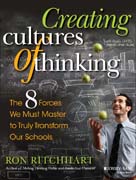
Creating Cultures of Thinking: The 8 Forces We Must Master to Truly Transform Our Schools
Ritchhart, Ron
Discover why and how schools must become places where thinking is valued, visible, and actively promotedAs educators, parents, and citizens, we must settle for nothing less than environments that bring out the best in people, take learning to the next level, allow for great discoveries, and propel both the individual and the group forward into a lifetime of learning. This is something all teachers want and all students deserve. In Creating Cultures of Thinking: The 8 Forces We Must Master to Truly Transform Our Schools, Ron Ritchhart, author of Making Thinking Visible, explains how creating a culture of thinking is more important to learning than any particular curriculum and he outlines how any school or teacher can accomplish this by leveraging 8 cultural forces: expectations, language, time, modeling, opportunities, routines, interactions, and environment.With the techniques and rich classroom vignettes throughout this book, Ritchhart shows that creating a culture of thinking is not about just adhering to a particular set of practices or a general expectation that people should be involved in thinking. A culture of thinking produces the feelings, energy, and even joy that can propel learning forward and motivate us to do what at times can be hard and challenging mental work. INDICE: List of Tables and FiguresAcknowledgmentsAbout the AuthorIntroduction: Demystifying Group and Organizational CultureA New Standard for EducationThe Forces that Shape CultureTools for TransformationChapter 1. The Purpose and Promise of SchoolsThinking Differently about OutcomesTeaching as EnculturationCulture as the Enactment of a StoryUncovering the Old StoryTaking a Hard Look at the Current StoryCrafting a Different Story for SchoolsEnacting Our New Story, Realizing Our VisionUncovering the Story of Your School or ClassroomChapter 2. Expectations: Recognizing How Our Beliefs Shape Our BehaviorFocusing Students on the Learning vs. the WorkTeaching for Understanding vs. KnowledgeEncouraging Deep vs. Surface Learning StrategiesEncouraging Independence vs. DependenceDeveloping a Growth vs. a Fixed MindsetExploring and Developing ExpectationsChapter 3. Language: Appreciating Its Subtle Yet Profound PowerThe Language of ThinkingThe Language of CommunityThe Language of IdentityThe Language of InitiativeThe Language of MindfulnessThe Language of Praise and FeedbackConclusionBecoming Proficient Users of the Languages of the ClassroomChapter 4. Time: Learning to Be Its Master Rather than Its VictimRecognizing Time as a Statement of ValuesLearn to Prioritize and Always Prioritize LearningGiving Thinking TimeInvest Time to Make TimeManage Energy Not TimeIt s Time to Rethink TimeRethinking TimeChapter 5. Modeling: Seeing Ourselves through Our Students EyesDispositional Apprenticeship: Being Role Models of Learning and ThinkingCognitive Apprenticeship: Making Our Thinking VisibleGradual Release of Responsibility: Modeling for IndependenceInteractive Modeling: Learning from Examples, Practice, and ReflectionLearning from ModelsModeling for the Development of Thinking, Learning, and IndependenceChapter 6. Opportunities: Crafting the Vehicles for LearningConstructing Character: Using Mathematics to Understand Othello s IagoVoiceThread: Using Story Telling to Understand MigrationMusic 2 Save MusicCategorizing, Recognizing, and Realizing Learning OpportunitiesAnalyzing and Creating Opportunities for LearningChapter 7. Routines: Crafting the Vehicles for LearningA Routine Is More than an ActivityUsing Claim–Support–Question to Delve into Number Theory in Fifth GradeMore Than a Game: Differentiating Mathematics in Second GradeMaking CSQ Fly in Secondary MathematicsTools, Structures, and Patterns: Establishing Routines in the ClassroomMaking Thinking Routine in Our ClassroomsChapter 8. Interactions: Forging Relationships that Empower LearnersNew Roles for Students: Empowering Disenfranchised LearnersBeyond Sit and Get: Teaching Students to Build on One Another s IdeasBuilding Culture through Affect and ActionsShaping Interactions through RolesAsking Good QuestionsCreating New Patterns of DiscoursePromoting Interactions that Support Thinking and LearningChapter 9. Environment: Using Space to Support Learning and ThinkingNew Learning in an Old ContainerCurating a ClassroomDesigning for ThinkingCreating Environments to Enhance Learning and Build Culture: Four FrontsCreating Environments that Bring Out the Best in LearnersChapter 10. Moving Toward TransformationSupporting Change on a Large ScaleBuilding a Vision across a School DistrictLearning Together for the Long HaulCreating OpportunitiesBuilding the Capacity of Teachers to Teach One AnotherForming Inquiry Action Groups to Go DeeperSameness and Difference in the Journey to a Culture of ThinkingAppendix A. My Reflections on the Learning Activities in this ClassAppendix B. Ladder of FeedbackAppendix C. Success Analysis ProtocolAppendix D. Looking at Students Thinking ProtocolAppendix E. Six Key Principles of the Cultures of Thinking ProjectAppendix F. Laying the Foundation for a Culture of ThinkingAppendix G. Leading a Culture of Thinking at My School: Self–AssessmentAppendix H. The Development of a Culture of Thinking in My Classroom: Self–AssessmentAppendix I. Assessment Ladder: Reasoning With EvidenceReferencesIndex
- ISBN: 978-1-118-97460-5
- Editorial: Jossey Bass
- Encuadernacion: Rústica
- Páginas: 384
- Fecha Publicación: 01/04/2015
- Nº Volúmenes: 1
- Idioma: Inglés
